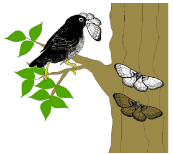
 Initially,
among B. betularia populations, both light-winged as well as dark-winged
individuals were present. This is an example of VARIATION in a population.
Initially,
among B. betularia populations, both light-winged as well as dark-winged
individuals were present. This is an example of VARIATION in a population.Understanding genetics at the population level is fundamental to studying evolution. Let's look at an example of how wing color in moths has been affected by industrialization. This example illustrates evolutionary processes and Darwin’s theory of natural selection.
Biston betularia is a moth that has light-colored wings with black speckles (hence its name "peppered moth") and is commonly found in Great Britain, In the late 19th century, during the industrial revolution in the U.K., trees near cities became blackened from pollution. Coincidently, biologists noticed the increasing presence of a dark-winged form of B. betularia in these regions. Dark-winged moths produce more melanin, or pigment, than light-winged moths. How did the dark wings evolve?

 Initially,
among B. betularia populations, both light-winged as well as dark-winged
individuals were present. This is an example of VARIATION in a population.
Initially,
among B. betularia populations, both light-winged as well as dark-winged
individuals were present. This is an example of VARIATION in a population.

As the industrial revolution progressed, and the bark of trees became darkened by pollution, the dark-winged moths had a higher survivorship and more reproductive success than light-winged individuals, which were eaten. This resulted in DIFFERENTIAL FITNESS between the two forms. This is because the dark color worked as a camouflage against the dark tree bark, thereby protecting them from predators (birds). The dark-winged moths were "naturally selected” for , and light-winged moths were “naturally selected” against, because of particular environmental conditions.
Finally, these variations were HERITABLE and therefore were passed on to offspring. More dark-winged parents survived to produced more offspring, and those offspring had dark wings. In contrast, fewer light-winged individuals survived to reproduce. This is how a population of mostly light-winged moths gradually gave rise to a population of mostly dark-winged moths.

In recent years, the sootiness that prevailed during the 19th century has gone, even from the urban cities of England. In parallel, the dark-winged form of the moth has declined dramatically in frequency since then. This shows how a particular trait might only be favorable under specific environmental conditions.